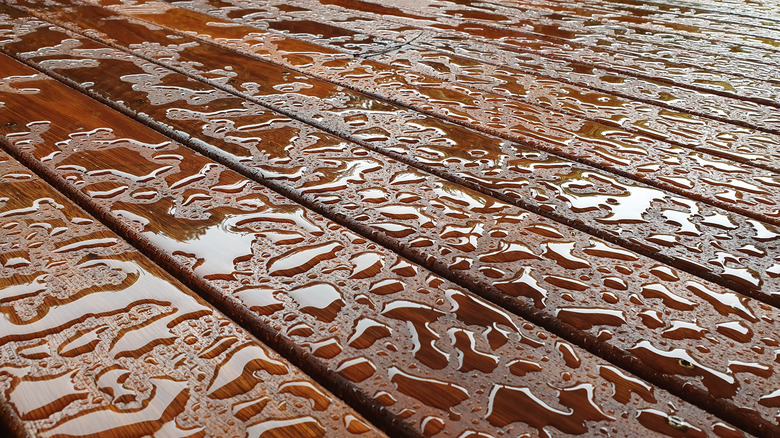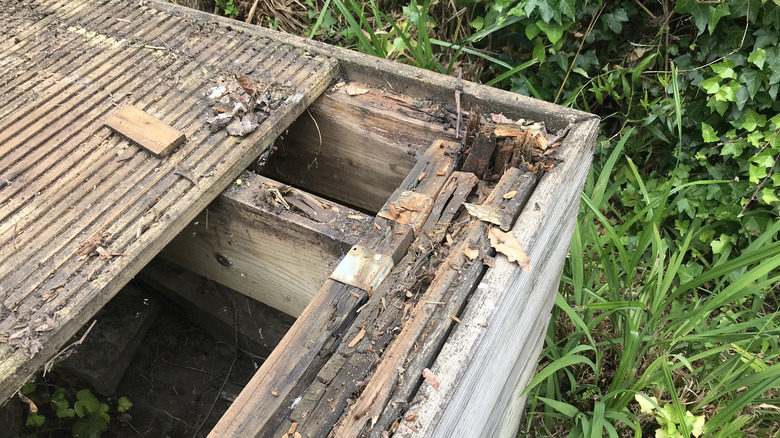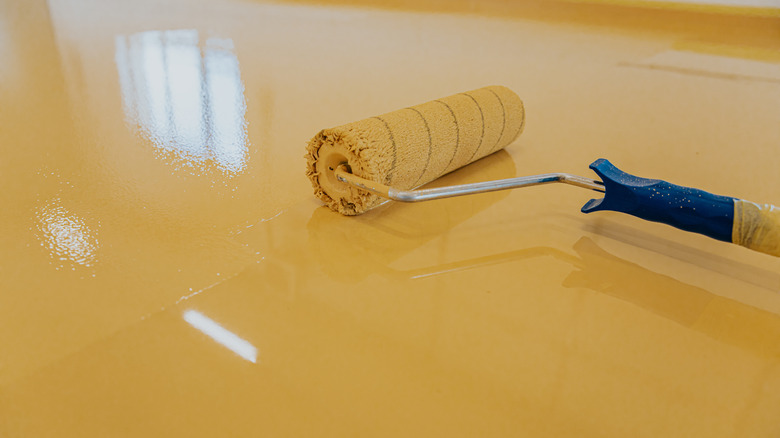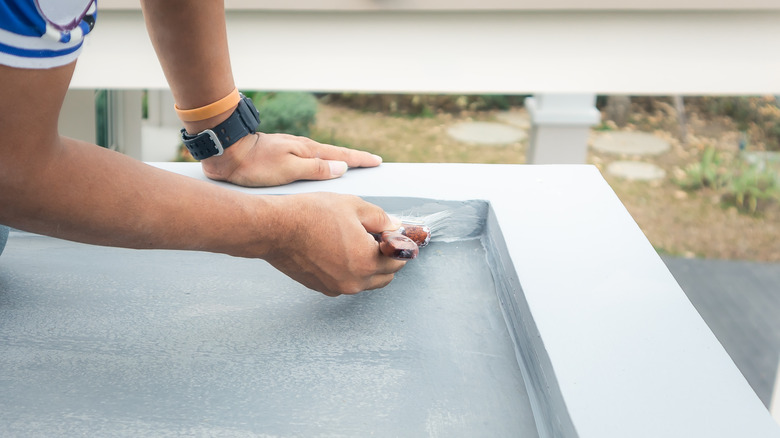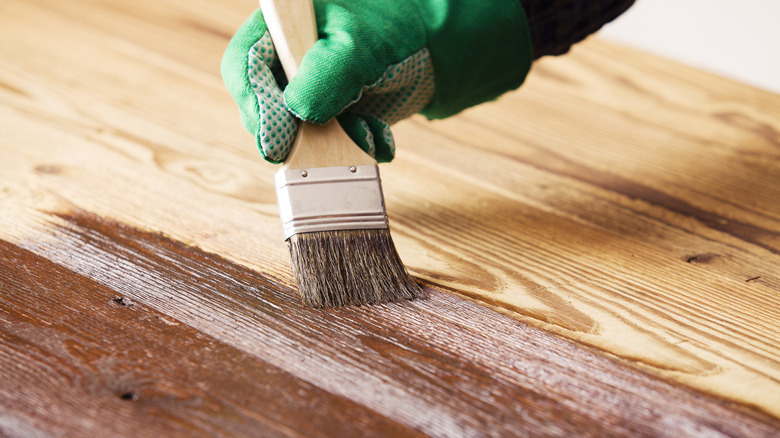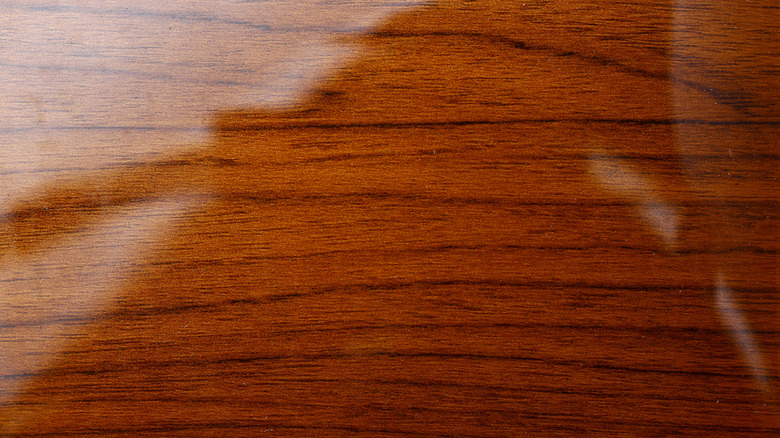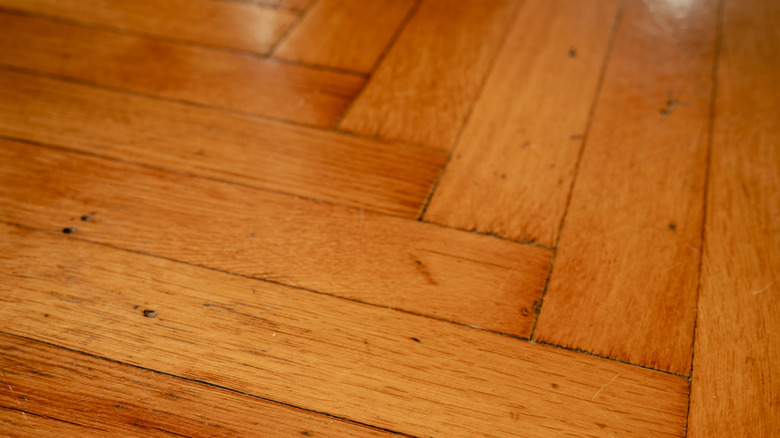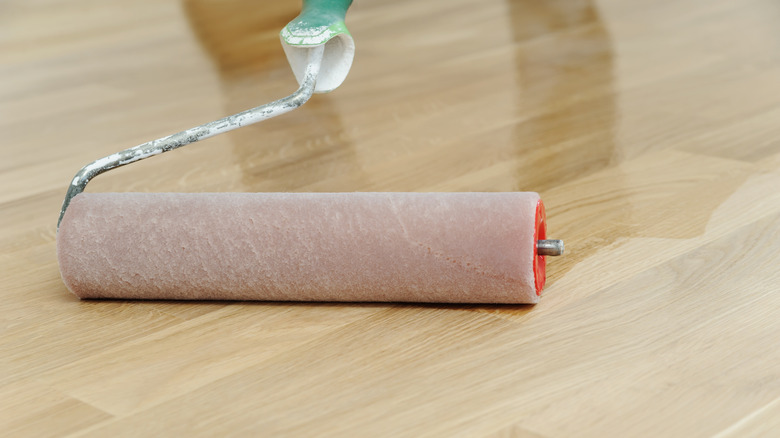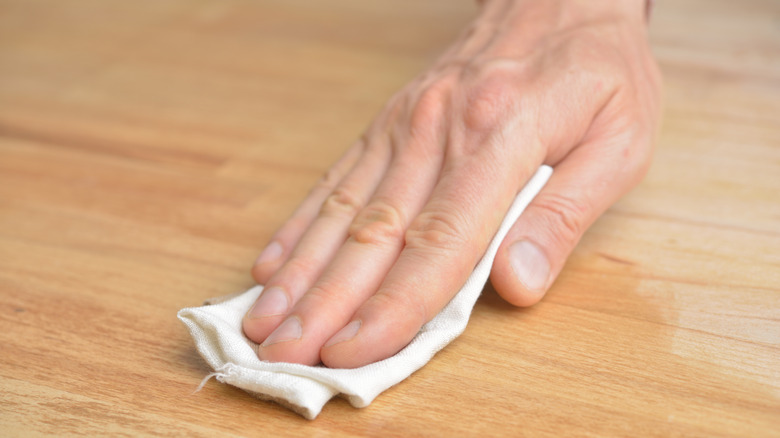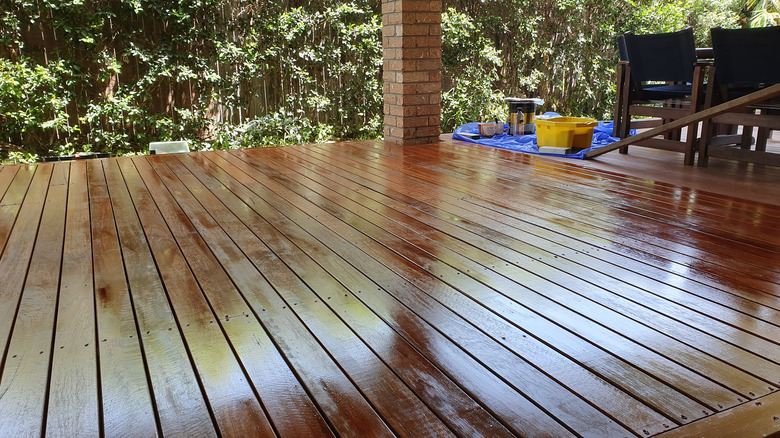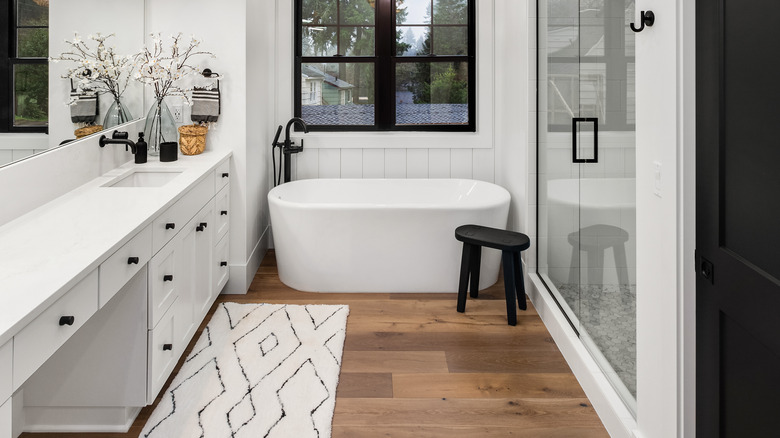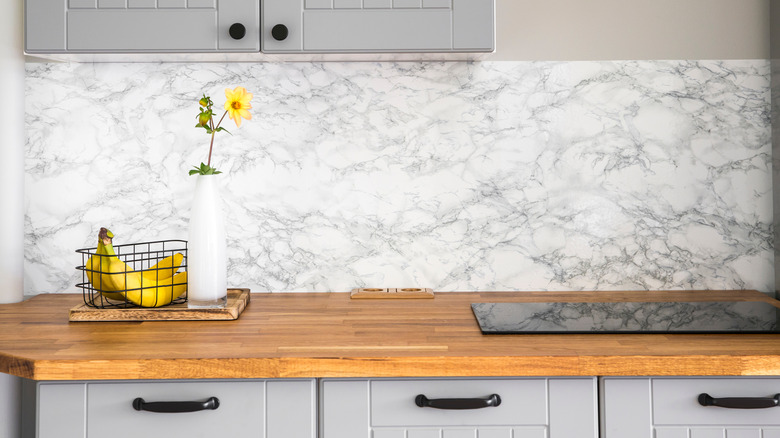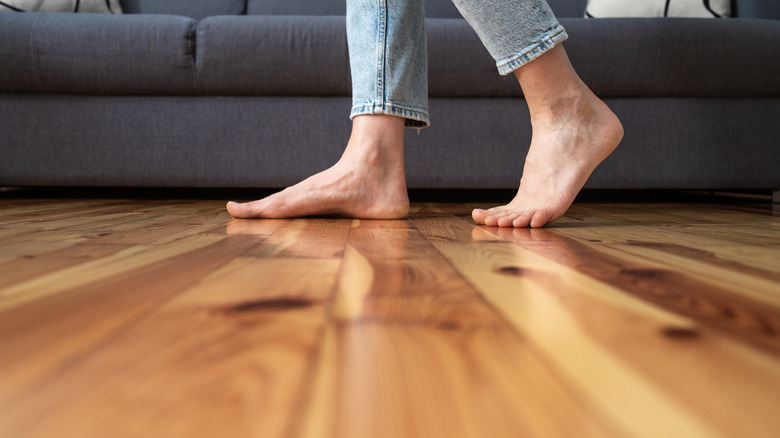What You Need To Know About Waterproofing Wood
Waterproofing is a crucial step in preserving the beauty and integrity of the exterior wood surfaces around your home. Due to weather conditions, exterior wood is exposed to moisture from humidity and water from precipitation. Additionally, even the interior wood in kitchens, bathrooms, and flooring may be subject to water damage. Though these facts are undeniable, architectural features made of wood add warmth and elegance to any home. According to From The Forest, the installation of hardwood floors in your home can yield a 75% return on your investment when it's time to sell. Yet, despite the timeless appeal of natural wood, homeowners know that water and moisture can be harmful to wood over time. Therefore, waterproofing becomes a necessary maintenance task.
The casual use of the term waterproofing may pertain to several processes. It does not always mean that the wood is rendered completely waterproof. Instead, certain wood-maintenance procedures ensure that wood is water-resistant. All the Science explains that water-resistant products can block moisture and water. Therefore, wood treated for water-resistance can stand up to outdoor weather elements. However, to be designated as waterproof, a product must remain undamaged when it is completely submerged in water. Most of the wood treatments marketed as waterproofing are actually closer to being water-resistant, not waterproof. Yet, with periodic re-application and maintenance, these treatments can be quite effective for protecting the wood in and around your home. Keep reading to learn more.
Why you need to protect the wood in your home from water and moisture
Several problems will occur if you do not take steps to protect the wood on your home's exterior from water, and the same can be said for the interior wood in locations where it might collect moisture. Rain, snow, and humid conditions threaten the exterior, while water leaks from sinks and pipes may cause water damage inside. According to Citywide Sundecks and Railings, the problem of wet rot occurs frequently in wood that is exposed to the elements. This includes decks, porches, siding, and columns. Indoors, wet rot may appear in wood countertops, cabinets, and flooring. Wet rot is caused by a cellar fungus (Coniophora puteana) that thrives in wet or damp wood, eventually causing the wood to soften and disintegrate. Therefore, taking protective measures against rot may save on expensive repair costs in the future.
In addition to the problem of rotting, wood that stays moist or wet extends an open dinner invitation to termites. Mitchell Pest Services explains that termites feast on the softened fibers of wet or damp wood. To protect your home from termite damage, it's wise to treat the wood with waterproofing or water-resistant products.
Waterproof wood with epoxy resin or epoxy paint
Epoxy resin adheres to wood, seals it, and makes it waterproof. It's commonly used on boats and other marine applications where a constantly wet environment threatens the integrity of the wood (via ProMarine Supplies). Additionally, epoxy resin is an excellent product for waterproofing wood around the home, especially in outdoor spaces where the wood is exposed to weather. Indoors, epoxy resin is used on wood that comes in contact with water sources, such as sinks. In these applications, the epoxy resin prevents leaks that might result in wood rot and expensive repairs.
Woodworking by LPI explains that paint reinforced with epoxy resin works well for waterproofing the wood in decks, porches, and other outdoor structures. It's available in a variety of colors to complement your home's exterior design. Unlike most paints, epoxy paint requires mixing two components: a resin and a hardener. It's best to sand, clean, and prime the wood before mixing the two parts of the epoxy paint. Then, immediately apply the mixture to the wood with a brush, roller, or sprayer. Allow it to cure for at least 24 hours.
Make wood water-resistant with the right paint
If you want to change the surface color while protecting wood from water damage, be sure to choose the right paint for waterproofing. Sherwin-Williams explains that paint slows down the natural process of moisture penetrating your exterior wood structures. It creates an impermeable coating on the surface. A high-quality, acrylic latex paint formulated for exterior wood works well because it breathes while still casting off water. This means that the paint has the ability to move when the wood swells and shrinks due to weather conditions. An oil-based exterior paint is an additional option for making exterior surfaces water-resistant, though it is not as flexible.
A Butterfly House notes that not all paint yields a waterproof barrier on wood. Over time, the paint will eventually develop cracks. When this happens, moisture seeps into the wood and causes damage. You can reduce future cracking by applying an oil-based, heavy-duty primer to the wood before painting it. The primer will seal the wood and create a strong, smooth surface to improve the paint's adherence. If you are painting outdoor wood furniture, be sure to prime and paint all surfaces, including the tops and bottoms of tables and chairs. In this way, you can block the absorption of moisture throughout the entire piece and preserve the wood for long-time use.
Use a stain to enhance the wood's ability to repel water
Although a stain does not make wood waterproof, it is a helpful step in preserving the beauty of wood while enhancing its ability to repel water. While paint forms an opaque membrane of color over a wood surface, a wood stain allows the natural grain to show through. Deck Master explains that, unlike paint, a wood stain is formulated to seep in below the surface of the wood. It may alter the color, but does not obscure the appearance of wood grain.
According to Wood Improve, a stain is thinner than paint. However, it's similar to paint in that there are multiple options in both color and consistency. Choices range from an extra light stain called toner to a thick stain called solid-color stain. A two-step process of staining the wood and following up with a coating of sealer may yield the best results to protect wood that is exposed to moisture or potential water damage. Staining with an exterior-grade stain and coating with a sealer are common options for maintaining outdoor decks.
Coat wood with polyurethane for water-resistance
According to Polyurethanes.org, polyurethanes are plastic polymers that we find in myriad products and applications. Examples include building insulation, the soles of shoes, auto parts, and more. Polyurethane sealer is a liquid application used to apply the plastic polymer to wood surfaces for the purpose of creating a moisture-resistant, outer barrier. It's a clear liquid that protects the wood without altering its color.
The Flooring Girl recommends applying three coats of polyurethane to protect wood floors. This creates a strong, water-resistant coating. However, it will wear down over time. When wood swells and shrinks, the rigid coating will form tiny cracks. Additionally, regular use such as foot traffic on floors and weather elements on decks will cause the polyurethane to wear away. Periodic maintenance that includes buffing and re-coating the wood surfaces with a new application of polyurethane will help to extend the water-resistant protection.
Treat wood with varnish for a sealed finish that sheds water
In bygone centuries, woodworkers made varnish by combining alcohol with wood sap from trees (via Resin Expert). Today, varnish formulations include solvents, resins, and oils. Varnish penetrates the wood and seals it. Due to the chemical reaction of varnish with the interior fibers, it usually darkens the wood. Yet, the treatment preserves the appearance of the wood grain. One advantage of using varnish is that it preserves the longevity of the wood. Instead of simply producing a membrane that sits on top, varnish seeps in to protect the internal wood fibers, as well as the outer surface.
According to AboutCivil.org, homeowners may choose from natural varnishes that derive from tree resin or modified natural varnishes that contain chemical additives. Marine and spar varnishes offer the greatest waterproofing capabilities. They are classified as long-oil varnishes. Alternatively, medium-oil and short-oil varnishes provide protective coatings that are more water-resistant, rather than waterproof.
For interior applications, lacquer yields a tough, water-resistant finish
Lacquer is a fast-drying sealant that protects wood from water damage. It's primarily used to treat wood furniture, cabinetry, and hardwood flooring in home interiors. Although some experts describe lacquer as a waterproofing product, others state that it just provides a water-resistant finish. Either way, a lacquer finish is tough and durable. Wood Magazine explains that professional woodworkers favor lacquer because they can spray it onto the wood to create a strong and smooth outer coating. DIYers may apply lacquer from an aerosol spray can or paint sprayer, or they may brush the sealant onto the wood.
Professionals apply lacquer in specialized conditions, using high-volume, low-pressure (HVLP) spray equipment. For DIYers, it's important to observe caution when working with lacquer. The toxic fumes from both water-based and solvent-based lacquers pose health dangers from to inhalation, as well as the threat of fire. When working with lacquer, it's imperative to provide ample ventilation and to wear safety glasses, gloves, and a respirator.
Apply natural oils to protect wood from water and moisture
Perhaps you want to go with eco-friendly, natural oils to treat the wood surfaces in your home. Tung, linseed, and walnut oils offer viable properties to make the wood water-resistant. Wood Finishes Direct notes that natural wood oils come from plant sources. These include vegetable oils, as well as the oils from trees, nuts, and seeds. Although woodworkers have used natural oils for thousands of years, current commercially-available wood oil products include solvents, chemicals, resins, and blends of oils. These ingredients produce faster drying times along with increased durability that adds longevity to the finish.
Wood oils work by seeping below the surface to fill the tiny openings in cellulose wood fibers. They then harden to produce a water-resistant finish. According to Christofix Woodworking, wood oil finishes are not as effective on exterior wood surfaces. However, they are especially useful inside to create a water-resistant finish on wood that will come into contact with food, as they are non-toxic. Therefore, natural oils offer desirable, safe properties for treating wood countertops and cutting boards.
Best practices for using stains and sealants for water-resistance
For exterior wood decks and porches, as well as interior wood floors, the two-step process of staining and sealing yields reliable results. A stain penetrates the wood and changes the color while still revealing the wood grain. Most sealers do not add color, but they contribute a hard finish. Although the process does not produce a completely waterproof surface, it does ensure water-resistance.
According to MasterClass, you should start with a clean wood surface. If the wood is rough, sand it first. Follow the manufacturer's directions to apply the stain with either a brush or a lint-free cloth. After allowing the stain to sit on the surface for a few minutes, wipe away any excess. Sand again between coats of stain, and remove the dust from sanding with a tack cloth. Once the stain has dried, it's time to apply a clear sealer, such as varnish or polyurethane.
Decks.com suggests precautions for staining and sealing your outdoor deck. The deck must be completely dry (at least 48 hours after the most recent rain), and the temperature must be between 50 and 90 degrees Fahrenheit. If you sand the deck before staining it, be sure to wear a face mask to prevent dust inhalation. Finally, pay attention to the cracks between the boards in your deck. Remove any loose debris from between the boards before you start staining. After the overall application, use a small brush to ensure that the sealer gets down into the cracks.
Options for protecting the wood in your bathroom from water damage
Natural wood adds to the beauty of a bathroom, but you'll need to protect the wood due to the moist conditions of its location. Waterproof Wiki explains that you can use an applicator gun to apply a thick sealing compound around bathtubs, showers, and sinks. When wood is also the material of choice for cabinets, countertops, and flooring, it's important to caulk the joints around all bathroom fixtures, thereby preventing water leaks and seepage.
One method to treat bathroom wood for water-resistance is to apply a penetrating wood oil, such as linseed or tung oil. Mix 1 part penetrating wood oil (not finishing oil) with 4 parts mineral spirits (or paint thinner) and apply with a brush. Apply three to four coats with 24-hour drying intervals and follow up with a coat of polyurethane. Another method involves the application of a water-resistant sealer, such as varnish. This may be applied as a single step or as a topcoat over water-resistant stain. Alternatively, you can make bathroom wood water-resistant via the application of a resin and acetone mixture. Acquire a resin formulated for waterproofing purposes and mix 1 part resin to 3 parts of 100% pure acetone. Apply three to four coats with a brush, allowing ample drying time between coats. It's important to observe the drying and curing times found in the manufacturers' directions. You may even need to avoid using the bathroom with the treated wood for a period of several days.
Treat the wood in your kitchen to prevent water damage
The kitchen is a place where water spills, drips, and leaks may be commonplace. Therefore, it's important to protect the wood on your kitchen floors, countertops, and cabinets. Vulnerable areas include wood under the sink, around the sink, and adjacent to the water faucet. Some treatments create a waterproof seal, while others provide water-resistance. According to Waterproof Caulking & Restoration, you can apply polyurethane caulk in the joints around sinks, faucets, and pipes to create a waterproof barrier. Be aware that silicone caulk does not adhere well to wood. A wood cabinet under a sink is a place that is subject to water damage, as well as mold growth, due to the water from leaky pipes. You can waterproof this area by coating the wood with a liquid rubber spray sealant.
Many people like the look of wood countertops, resembling a butcher-block. For this food preparation area, it's important to protect the wood from water and moisture while maintaining a food-safe surface. Hardwood Reflections recommends several natural oils for treating wood countertops. These include tung, linseed, mineral, and walnut oils, as well as beeswax. Shellac and carnauba wax are additional options. While these treatments do not create a waterproof wood surface, they do produce water-resistance. Experts recommend re-application of wood oils every few months.
Create water-resistance for your interior hardwood floors
Hardwood floors add to the home's ambience and resale value. To preserve their beauty and keep them in tip-top shape for many years, it's wise to protect them from water damage due to spills, leaks, and wet footprints on rainy days. According to Wood N Beyond, many processes contribute to water-resistance for hardwood floors. Your best bet is to apply three or more coats of waterproofing polyurethane or resin, following the manufacturer's directions for drying times between coats. If you see bubbles in the finish, sand them out before applying the next coat.
ESB Flooring points out that you should clean and sand your floors before applying any waterproofing products. Be sure to vacuum, clearing the dust away after sanding. Products such as lacquer, varnish, and polyurethane create a hard finish on the wood surface. These treatments produce a water-resistant finish more readily than wood oil treatments do. Even when floors are treated with waterproofing polyurethane or resin, you should mop up spills and leaks immediately. Avoid allowing liquids to sit on the wood floors. With normal traffic and use, any finish will wear down over time, so wood flooring does require re-finishing every few years.
